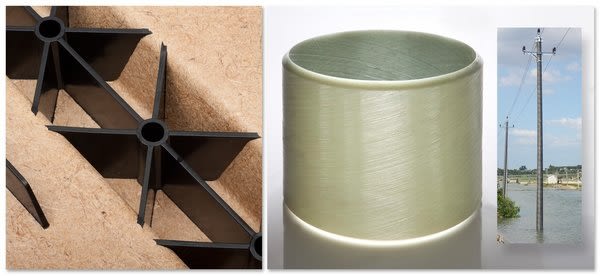 As a supplier and development partner for composite applications involving polyurethanes, epoxy resins and thermoplastics, BASF will be participating in the "JEC Composites Show", which runs from March 10 to 12, 2015 in Paris, Hall 7.2, Booth F 51. This trade fair is considered one of the world's most important exhibitions for specialty materials.
As a supplier and development partner for composite applications involving polyurethanes, epoxy resins and thermoplastics, BASF will be participating in the "JEC Composites Show", which runs from March 10 to 12, 2015 in Paris, Hall 7.2, Booth F 51. This trade fair is considered one of the world's most important exhibitions for specialty materials.Infrastructure: Ultra-light utility poles made of Elastolit withstand extreme loads
BASF presents a new type of very strong and wind resistant utility pole made with BASF's polyurethane system Elastolit. The technology is already proven in China and now available in Europe as well.These poles based on a filament winding technology are much lighter and at least 2.5 times more wind-resistant than the commonly used concrete utility poles for medium voltage grids. Due to their very light weight – a 12 meter composite pole weighs only 250 kg – they are easy to install and no heavy equipment is needed when erecting the poles. The bending strength of the new type is at least 2.5 times higher compared to concrete poles which allows long distances between the single poles of up to 120 meters.
The utility poles already proved their superior wind resistance during last year's typhoon "Rammasun" in China. The storm destroyed 70.000 concrete and metal utility poles while none of the polyurethane based utility poles were affected and are still in service.
Automotive: Examples of various composite materials for high-performance composite parts
BASF is showing examples of new uses for thermosets and thermoplastics for automotive lightweight design. These achieve further reductions in component weight and CO2 emissions. The structural component exhibited was made by wet pressing with an Elastolit RTM polyurethane system (RTM: resin transfer molding) in an experimental mold. The Elastolit used here features fast curing, very good fiber impregantion, and excellent fatigue properties.For MAI Qfast, a project involving Audi, BMW, the Fraunhofer Institute for Chemical Technology and KraussMaffei in the MAI Carbon Cluster, a part of a generic vehicle structure has been optimized and manufactured using various composite production processes. Two demonstrator parts can be seen on the BASF stand: the RTM variant of a generic floor structure produced with the epoxy system Baxxodur; and a thermoplastic variant with load-path-optimized reinforcement made of UltratapeTM from BASF – a carbon-fiber-based system using unidirectional tape. In both cases optimization using BASF's Ultrasim simulation tool was the key to achieving compliance with the component specification together with a significant weight saving. So while BASF's Ultrasim was already a valuable design tool for the continuous-fiber-reinforced thermoplastic composite system UltracomTM, the simulation toolbox has now also been extended to reactive processes like RTM.




